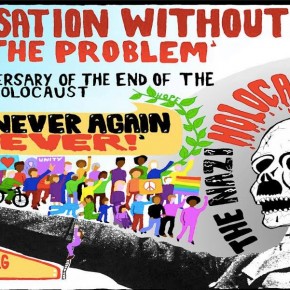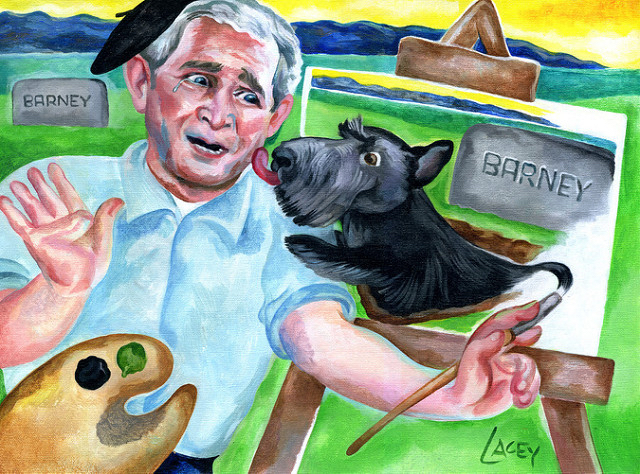The object of most conspiratorial fantasies in America is the federal government. This is no coincidence. Ever since the New Deal, and the Civil Rights Movement, the executive has been the most prominent guarantor of democratic change. In growing federal power, racists, evangelicals, and the business class found a common enemy to unite against.
It is not incidental, but rather a result of the inner logic of the conservative project, that reactionary politics have always traded in conspiracy, paranoia, and more explicit hatreds.
This “lunatic fringe” is nothing but the logical end result of a politics built on fantasies of oppression, and has more often than not been a useful supplement to mainstream conservatism, injecting into its bloodstream that extra dose of fanaticism that has made it so successful.
In order to sustain itself, American conservatism asks of its foot soldiers to be constantly on guard against threats and enemies to average Americans, as though they were identifiable. It’s the paranoid style first identified by historian Richard J. Hofstadter, in 1964, in reference to the New Right, and Barry Goldwater . The problem is that it is purely reactive – it lacks a transformative vision that would be attractive to broad based people’s movement.
Is it any wonder, then, that among the very real threats to privilege, like multiculturalism, and the welfare state, the outlook also regularly summons phantasmagoric ones, to keep the rank and file on its feet? For rightists, their disconnect from reality is not a liability, but a source of strength. Paranoia is its mobilizing force. Their militancy is a sign of profound anxiety, reflecting how strongly they have been convinced to identify with the status quo.
But the politics of victimhood are not just about fear. They have identifiable political consequences, such as the country’s rabid gun culture, and its principle defender, the National Rifle Association. The Obama era, just like the Clinton period before it, not only saw the rise of an extreme political opposition (the beginnings of the Tea Party and the Gingrich revolution, respectively), but the most extreme expression of this politics, in the form of of right-wing terrorism, armed militias, and murder. The 1994 Oklahoma City Bombing is perhaps the most extreme example.
The most explicit, and literal-minded manifestation of this confluence of resentment and violence may be the Sovereign Citizens Movement, which rejects the legitimacy of both federal and state laws. These ideas first popped up in the 1960s, when the Posse Comitatus, a collection of white supremacists, anti-Semites, and radical Christians, used them to rebel against the “illegitimate” federal state.

But only in recent years, as libertarian ideas proliferated in American culture, have they found a real social base. By some estimates, there are up to 300,000 Sovereign Citizens in America today.
Even though most are more pedants than terrorists, more tax-protesters than militia members, the idea of violent insurrection is never far from their minds.
In a 2014 survey of law enforcement officials, asking them about their perception of threats to the United States, Sovereignists were ranked the highest – even above the threat of Islamist terrorism.
As with most conspiracy subcultures, the precise content of their often complex and byzantine belief system is less significant than the cultural tides they are riding: distrust of government, hyper-individualism, and reactionary resentment. In this, Sovereign Citizens, like white nationalists, who are equally obsessed with ‘sovereignty’, offer a distorted mirror-image of the ordinary conservative message: the levers of government have been taken over by the enemy.
To take power back, and to reestablish the only legitimate and more limited legal order, any means may be acceptable. Even such an establishment’s pet as Charles Murray has recently published a book calling for civil disobedience and resistance to the feds.
More and more people are feeling betrayed by their governments. Without a positive alternative, they are drawn to a defensive nationalism, or the individualist paranoia of vigilante libertarianism – every man for himself. These movements may be fascist, but they haven’t grown outside of the liberal political habitat. They are a product of our times, and often only extreme reflections of mainstream developments and attitudes.
For many years now, we have been told again and again that solidarity and equality are mere liabilities in the global marketplace. In the endless War against Terror, the rule of law and cultural tolerance are weaknesses we may no longer be able to afford. Instead, we are told, we need to be harsh and vigilant in defending ourselves.
To a professional politico, all of this is just good messaging: a clever way of selling militarism, surveillance, and neoliberal adjustment to the proles. But many Americans, lacking the upper class’ innate sense of security, have come to feel it in their bones. They genuinely believe that their world is under threat. White nationalists are merely demonstrating that they have learned this grim and apocalyptic lesson.
Photographs courtesy of Marylin M and Max Sparber. Published under a Creative Commons license.





